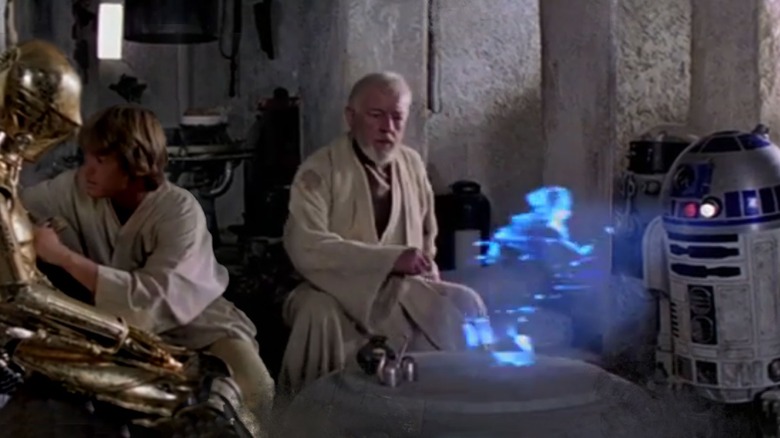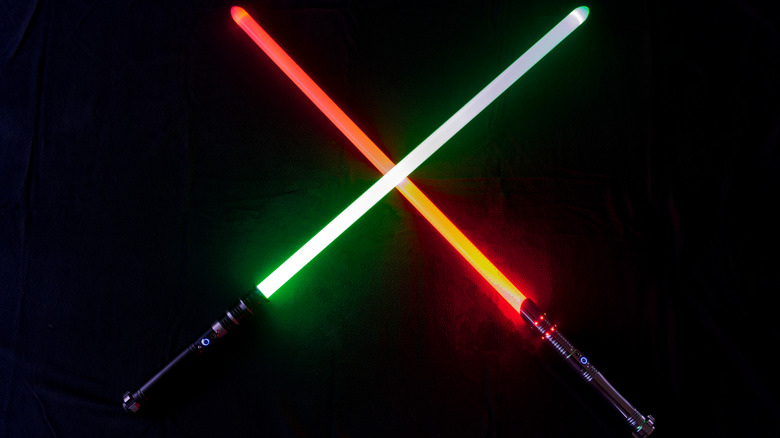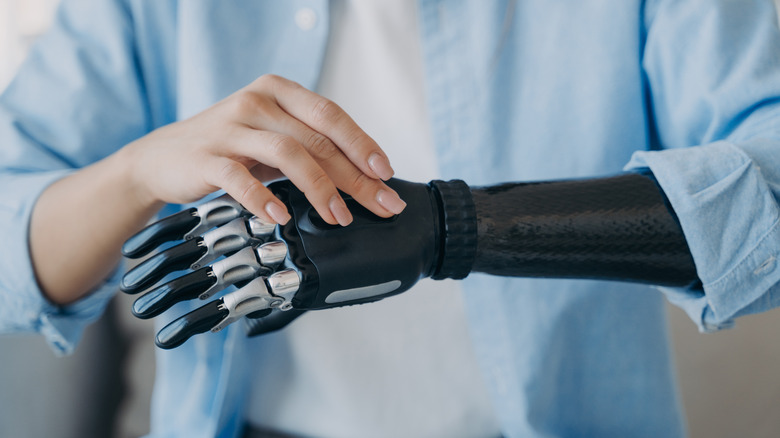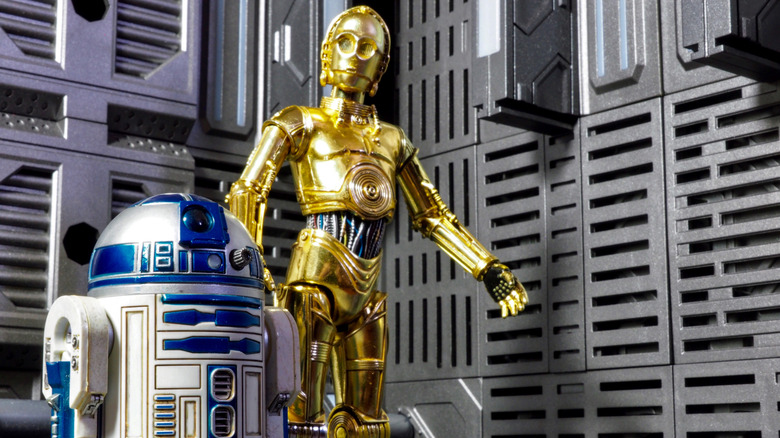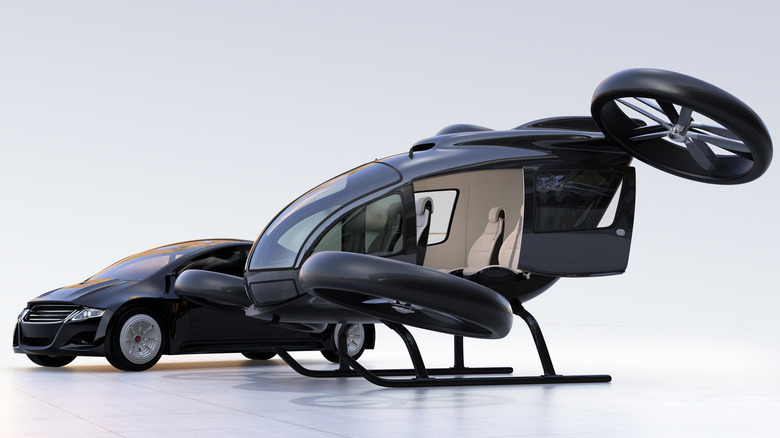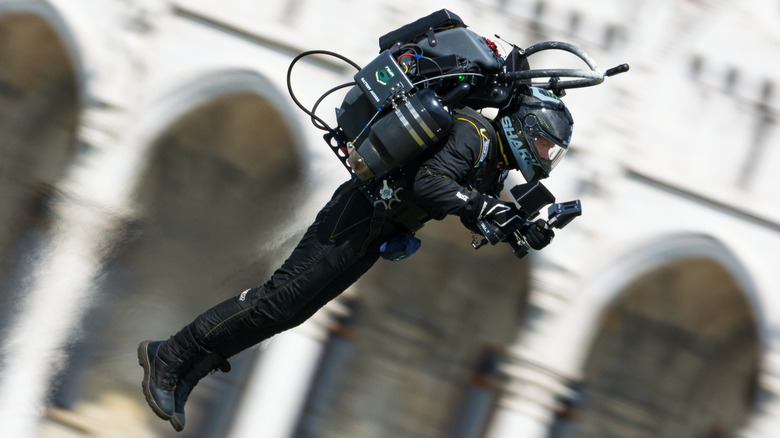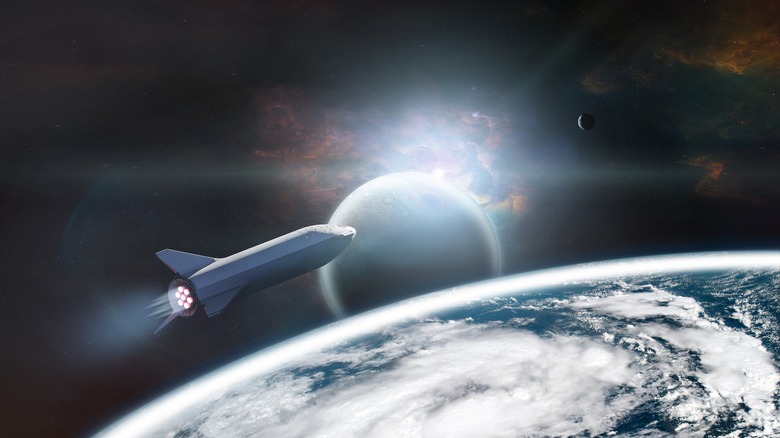Old-School Sci-Fi Star Wars Tech That's Since Become Reality
Has any franchise been more influential than "Star Wars?" This classic science fiction saga has been capturing the imaginations of audiences for generations, working its way into almost every facet of society. Even President Reagan's Strategic Defense Initiative, nicknamed "Star Wars," was a program to develop X-ray lasers that could shoot down nuclear missiles.
Both old-school and modern Star Wars movies and episodic series are chock-full of iconic technology, like lightsabers, blasters, spaceships, robots, and holograms. Have you ever wondered if this "Star Wars" tech could become a reality? Would you be surprised to know that quite a few pieces of sci-fi tech that first appeared in "Star Wars" has since become realized in our real world?
Since the release of "Star Wars: A New Hope" in 1977, scientists and engineers have been working to make the technology from "Star Wars" a reality. While we may not have personal blasters in our gun belts just yet, several Star Wars-inspired technologies are already in use, and some are close at hand.
Laser Cannons and Energy Weapons
"Star Wars" has tons of ship-to-ship laser battles and lightsaber duels that light up the big screen. Audiences cheered when Luke shot down his first tie fighter, and gasped in horror when Alderaan exploded from the awesome power of the Death Star.
But "Star Wars" didn't just inspire the fans. Lockheed Martin developed their own miniature Death Star Superlaser. It may not be able to destroy a planet, but the deck-mounted Layered Laser Defense (LLD) just underwent trials and successfully shot down several drones and a simulated cruise missile.
While the U.S. military currently relies on conventional weapons, the Navy already has one ship equipped with a militarized laser. As technology improves, there is no doubt that laser-based weaponry will become more common.
Laser weaponry may already be in use, but if you're waiting to get your hands on the iconic lightsaber, you may have a long while to wait. The technology to create a working lightsaber that can cut through carbonite like butter simply doesn't exist. Daring engineers have made some devices that can melt through steel, but they're currently just decorative fire sticks or plasma torches that require you to carry a fuel tank on your back.
Bionic body parts
In a galaxy far, far away, bionic arms are commonplace pieces of medical technology. Heroes and villains alike lost a limb or two in battle and needed cybernetic replacements. Just before the iconic scene in which Darth Vader reveals himself to be Luke's father, Luke Skywalker loses the duel, and consequently, his hand.
Before the end of the film, Luke is fitted with a bionic hand that functions and looks like a real hand. Technology today has advanced to the point where robotic prosthetics are possible and are no longer science fiction. Although prosthetics were commonplace at the original release of "Star Wars," they had limited functionality. Today, bionic or electromechanical limbs are fast becoming a tangible reality for people with missing limbs.
One of the most notable companies is OpenBionics which has created the Hero Arm prosthetic. The Hero Arm is a true bionic arm that comes with several different grip strengths and settings.
In the future, bionic arms could be used for even more than just a tool for amputees. They could be used to enhance our abilities even further — to the point where we become superheroes. The possibilities are endless and the technology necessary to make it all a reality is on the horizon.
Droids for peace and war
Droids were at the core of almost every major event in the "Star Wars" storyline. Wherever Luke, Anakin, or Rey went C-3PO, R2-D2, or BB-8 were right behind them. Droids filled every conceivable role in the "Star Wars" universe and, in our galaxy, droids are also becoming more ubiquitous.
Assembly lines and human factory workers have largely been replaced by precision robots. They've been around for years as the unseen mechanical workforce of today and while they're not plucky robot companions like R2-D2, that eventuality may be more reality than fiction.
Companies like Boston Dynamics have spent the last several decades developing an honest-to-goodness humanoid robot. The newest iteration of the Atlas humanoid robot can independently pick up and move objects, navigate a parkour course, and do a backflip. It looks like something straight out of Star Wars, but better. The Atlas' range of motion is surprisingly better than its onscreen counterpart C-3PO.
If you've ever wanted your own quirky pet-like robot companion similar to R2-D2 or BB-8, be sure to add Boston Dynamics' Spot to your wishlist. While Spot is an incredible feat of modern engineering, he's not very cuddly and will set you back around $75,000 to own.
Holograms and multidimensional projection
The first time Princess Leia appeared as a recorded hologram, audiences were stunned. In subsequent "Star Wars" movies and TV shows, holovids projected real-time or recorded imagery and sound over vast distances through the "Holonet." This is slightly less exciting in our real world today since most people carry a mobile communicator in their pocket everywhere they go. Smartphones and the internet have replaced the need for holographic communication devices.
Holograms may not be the way we communicate, but there's no denying that hologram technology is real and we've only just begun to tap into its potential. Today, holograms are mainly used for a variety of mundane activities like data storage and medical applications but are making a splash in the entertainment sphere.
In 2012, hip-hop fans were treated to that same feeling of wonder when deceased rapper Tupac appeared, not on-screen, but on the actual stage. Hologram Tupac interacted with the crowd and performed "2 of Amerikaz Most Wanted" with Snoop Dogg at Coachella. The hologram looked so realistic that some fans thought that Tupac was alive and in hiding since 1996.
A German circus (Circus Roncalli) replaced all of its animal acts with holograms in an attempt to fight animal cruelty. These beautiful illusions have captivated attendees since the company made the switch in 2018.
Researchers at the University of Sussex have taken it one step further, positing a tactile hologram. Instead of using laser light projectors to create a 3D image, their research involves a super light substance (foam bead) that's moved around using ultrasound waves. Not only does the Multimodal Acoustic Trap Display (MATD) create illusory displays, the projections can produce sound and be touched by users — getting two other senses involved.
Speeders and Hovercraft
Hovercars and other floating "Speeders" are a staple of science fiction and the preferred way to get around planetside whether you're on Tattooine or Endor. But what if you're on Earth?
Hovercraft technology has been around in one form or another since the 1950s, but we still put rubber to the road when it comes to the morning commute. This is mainly because attempting to drive a hovercraft to work is an extremely expensive (not to mention, inefficient) option. You might as well hire a helicopter to drop you off at work.
This doesn't mean that cars will always be the kings of the road, however. Hovercrafts enjoyed a bit of a renaissance in the early 21st century when we started seeing stylish and speedy hovercraft designs that remind us all of a Landspeeder, cruising across the deserts of Tatooine. Nowadays, YouTube is filled with garage engineers and motivated individuals who have made their very own speeders and hovercrafts.
If you want to get your hands on your very own Speeder, look no further than Aerwins Technologies, a startup from Japan. Aerwins is one of the first companies to bring a commercial speeder to life. The Xturismo looks like it could have been in any of the new "Star Wars" sequels. It's sleek, hovers, and flies, but it's loud enough to blow out the eardrums of anyone standing nearby.
Jetpacks for personal transport
Although Boba Fett only uses his jetpack once in "Star Wars: Return of the Jedi" — and its malfunction is what sent him rolling into the Sarlacc pit — it's still one of the coolest gadgets in the series. Later "Star Wars" spinoffs, sequels, and video games feature jetpacks and jump jets in a big way.
Numerous companies and individuals have attempted to create a working jetpack since 1919 and it's finally become a reality. Some of the most notable are the JetlLev and Flyboard which let thrill seekers hover over 30 feet in the air, diving in and out of the water. The only problem is that they're completely useless outside of water and are relegated to an overpriced beach vacation novelty.
If you're looking for the real deal that can take you from a generic Stormtrooper to an elite flying Mandalorian, Gravity Industries have created a working jetpack with back and arm-mounted engines that can let you soar. It's even being tested for military and emergency rescue applications.
Underwater Cities
The exotic locales in "Star Wars" have sparked the imaginations of generations of viewers. Mustafar held a hidden base in the depths of a volcanic planet, Bespin is home to the Cloud City, and the Gungans live in underwater cities in the oceans of Naboo.
These fantastical locations are the stuff of great science fiction, but one is much closer to reality... the underwater cities of Naboo. Living underwater raises numerous problems that as humans, we're not naturally able to handle. However, there are several jobs that require people to live and work underwater for long periods of time.
Saturation divers live in pressurized pods for weeks at a time so that they can work at great depths either welding or maintaining underwater equipment. Staying in a pressurized environment is key to continually living at depth. Although the pressurized pod is usually above water and they are lowered in a pressurized bell capsule, divers are not allowed to leave until their month-long shift is up.
It's not quite an underwater city, but the Project Tektite research habitat is the closest thing in recent history (Tektite III was dismantled in 1991). Project Tektite was a submersible research lab that broke the record for the longest continuous underwater saturation dive at 58 days. NASA also conducts astronaut training in its own underwater facility — albeit in a pool, not in open water.
Underwater cities may yet become a reality as companies like the Shimizu Corporation look to the ocean as the next big real estate market. The Shimizu Corporation has designed a future underwater city concept called Ocean Spiral that wouldn't look out of place in the next Star Wars production.
Commercial and Private Space Ships
In a galaxy far far away, spaceships are commonplace, and one of the preferred methods of travel throughout the galaxy. Whether you're flying a customized YT-1300 (Millennium Falcon) or a Firespray Gunship, cheap and fast space travel is the norm for those in the "Star Wars" universe.
In our own galaxy, it's not that cheap or commonplace to own your own spaceship, but it's definitely in the realm of possibility. Backyard astronauts and billionaires have been testing and pouring their money into their own space programs. Several non-government space expeditions have been launched, proving that if there's a will, there's a way.
Although SpaceX might be the company that springs to mind, actually quite a few companies and individuals have made orbital flights and breached our atmosphere. The most notable was the first and prizewinner of the Ansari X competition, Burt Rutan.
Burt Rutan participated in the Ansari X competition that awarded $10,000 to the person who successfully built and launched a reusable spacecraft twice within one week. Burt Rutan built and designed SpaceShipOne with funding from Microsoft co-founder Paul Allen. This was the first private spacecraft to successfully make it into orbit.
Today, however, many major companies have their own space programs and are constantly improving their designs. Virgin Galactic, Blue Origin, and SpaceX have also successfully launched several private spacecraft in the hopes that one day soon space travel will be available to the general public.
Carbonite Freezing
One of the most enduring scenes in all of the "Star Wars" movies is when Han Solo is lowered into a pit and frozen in a solid brick of carbonite. When "The Empire Strikes Back" was released, humans weren't yet successfully freezing themselves in any sort of material (not long-term, anyway).
Now, you too can freeze your loved ones to thaw out later with cryogenic technology. However, that's only true if your loved ones are fish embryos. Similar to "Star Wars" carbonite freezing, cryogenics attempts to rapidly freeze a creature or human so that tissue is not damaged. They then must be revived at the proper temperature and rate to avoid damage to the frozen tissues.
Since its inception, there have been approximately 500 people who have opted to have their bodies cryogenically frozen in liquid nitrogen in the hopes that they can be successfully revived when modern medicine has come up with a cure for what ailed them.
While researchers say the science is feasible, currently, the technology to successfully revive anything larger than roundworms or fish embryos has proven unsuccessful, but it's in the realm of possibility.
Cryogenics and carbonite freezing have been a staple of science fiction and are even possible solutions for long-term space travel. However, until scientists can consistently freeze and revive humans, this practice will remain in its experimental stages. You can still pay to have you or your loved ones frozen, but they'll have to remain frozen until science catches up to fiction.
Mobile phones and Long-Distance Communication
"Execute order 66." These words rang throughout the galaxy as Emperor Palpatine solidified his power over the Galactic Senate and simultaneously murdered the majority of the Jedi. This simultaneous attack was only possible because of instantaneous long-range communication. With a single phrase, the Jedi were reduced from one of the strongest forces in the galaxy to a handful of members in hiding.
In the real world, there are few things that have changed the world more than communication technology. It may not seem that exciting, but the smartphone you're reading this article on is one of the most advanced pieces of technology out there. With it, you have access to instantaneous communication with practically every person on the planet as well as access to the internet, which, in turn, comprises nearly the entirety of humanity's collective knowledge.
The first cell phone actually predates the first "Star Wars" film by 4 years. The first cellphone call was made in 1973, and "A New Hope" was first released in 1977. However, "Star Wars" made a point of showing how handheld communicators (mobile phones, if you like), could change the way we communicate in a big way.
Vibroblades
If you've never heard of Vibroblades you're probably not alone. Vibroblades were standard weaponry in the Old Republic days of "Star Wars" when Jedi and Sith were more common figures in the galaxy.
Vibroweapons like Vibroswords, Vibroblades, and Vibroaxes were just like their non-moving counterparts, but they vibrated at a high frequency that allowed them to cut through armor and steel just like a lightsaber. As far as official canon goes, they not only feature in "Star Wars" video games, but Din Djarin, the hero of the first several seasons of "The Mandalorian," is known to carry a Vibroblade knife in his boot.
If you'd like to carry around a vibrating knife that can cut through the toughest materials, you may need something a little larger than a boot to carry it around in. Vibrating or ultrasonic blades are real, and can be used for both commercial and industrial uses. They tend to require a lot of energy and need to be plugged into a power outlet, making them a little impractical as a boot knife.
Rather than slicing through armor, today, ultrasonic blades are commonly used in surgeries or for cutting food. In the operating room, these blades are known as ultrasonically activated scalpels (UAS) and can both rapidly cut and coagulate the blood during an operation to minimize bleeding in a patient. This tool has allowed many general and laparoscopic surgeries to be less invasive with improved precision and simplified processes.
Artificial Intelligence in Navigation
R2-D2 is a constant companion of Luke and one of the iconic characters in the "Star Wars" universe. There are very few things that this fan favorite Deus Ex Machina can't do. Among R2-D2's many talents is its ability to fly spaceships without any supervision. Many tech companies strive to make the idea of self-driving cars and autonomous transportation methods a reality, and it has actually been achieved with varying degrees of success.
Google isn't the first company to achieve a self-driving car, but it has created one of the most recognizable versions on the road today with Waymo. There are quite a few tech companies that have created AI-navigation cars outside of Google as well. Tech giants Baidu, Mobileye, and even Tesla are working hard to refine their algorithms to create even more efficient and safe automated navigation.
Part of the ubiquity of Google's Google Maps is its fleet of self-driving cars that gather data for Google Street View. These cars are released into the wild and periodically take 360-degree photos without any human input, much like R2-D2 piloting the X-Wing while Luke Skywalker takes a nap on the way to the Dagobah system.
Tractor Beams
A tractor beam is in the very first scene of "Star Wars: A New Hope" when the Empire attempts to capture Princess Leia. Tractor beams make another appearance later on in that same movie and are shut down just in time to allow the Millenium Falcon and crew to escape from the Death Star.
Believe it or not, tractor beams have existed for some time, albeit on a much smaller scale than in science fiction. Microscopic tractor beams, also known as optical tweezers are used in scientific and medical research to manipulate tiny nanoparticles and even atoms.
Arthur Ashkin won the 2018 Nobel Prize for the development of optical tweezers. These mini tractor beams or optical tweezers can be used to pick up microscopic objects like individual bacteria without harming them. These devices are still in use by the scientific community as a way to control and isolate small particles in biological research.
Research published in Optics Express by a pair of researchers in China outlined how they were able to move a macroscopic object (visible to the naked eye) using only lasers. These scientists were able to point a laser at an object and force it to move far enough to be detected by the human eye without any additional measuring instruments.
As exciting as that sounds, the object in question was designed specifically for this experiment and was only moved a few centimeters. This is not going to allow police officers to swap out their radar speed guns for tractor beams, but it does prove that the science behind tractor beams is possible.
